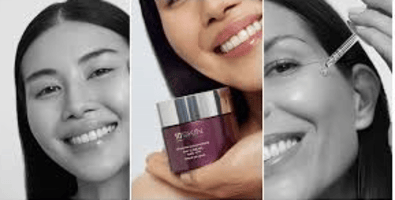Creating an effective skincare routine tailored to your specific skin type can transform your complexion and boost your confidence. Building a skincare routine for your skin type doesn’t need to be complicated or expensive.
It just needs to be consistent and appropriate for your skin’s condition. Many people struggle with finding the right products or knowing which steps to follow, often using products that worsen their skin concerns rather than improve them.
This guide will break down everything you need to know about creating a personalized skincare routine for your specific skin type, from identifying what skin type you have to selecting the right products and establishing a morning and evening routine.

Understanding Your Skin Type
Before building a skincare routine for your skin type, you first need to understand exactly what type of skin you have. Although heredity determines your skin type, a number of factors, such as climate, nutrition, hormones, and the products you use, can also have an impact.
The main skin types include:
- Normal skin – well-balanced, not too oily or dry, few imperfections, and rarely sensitive
- Dry skin – tight, flaky, rough texture, more visible fine lines, and prone to irritation
- Oily skin: increased sebum production, shiny look, pores which is enlarged, and prone to acne
- Combination skin: oily in certain places (usually the T-zone) and dry or normal in others
- Sensitive skin – easily irritated, prone to redness, itching, burning, and adverse reactions
How to determine your skin type
The cleansing method is a simple way to identify your skin type. Wash your face with a mild cleanser and let it dry, wait an hour, without using any product.
Then, observe your skin:
- You probably have dry skin if it appears flaky and feels tight.
- If your face looks shiny all over, you probably have oily skin
- You have mixed skin if your cheeks feel normal or dry but your T-zone (forehead, nose, and chin) is oily.
- You probably have sensitive skin if it regularly reacts to products by becoming red or irritated.
Essential Steps in a Skincare Routine Any Skin Type
When building a skincare routine for your skin type, certain steps are fundamental regardless of your specific skin condition. Here’s a basic framework to follow:
 Morning Routine:
Morning Routine:
- Cleanse
- Tone (optional)
- Treat (serums/specialized treatments)
- Moisturize
- Sun protection
Evening Routine:
- Cleanse (double cleanse if wearing makeup)
- Tone (optional)
- Treat (serums/specialized treatments)
- Moisturize
Now, let’s adapt this framework for each skin type.
Building a Skincare Routine for Dry Skin
Dry skin feels tight and flaky because it lacks moisture and oil. When building a skincare routine for this skin type, focus on hydration and nourishment.
Morning Routine for Dry Skin
- Cleanser: Use a cream or oil-based cleanser that doesn’t strip your skin of its natural oils. Stop using drying foamy cleansers.
- Toner: Opt for alcohol-free, hydrating toners containing ingredients like hyaluronic acid, glycerin, or rose water.
- Serum: Look for serums with hyaluronic acid, vitamin E, niacinamide, or ceramides to boost hydration.
- Moisturizer: Choose rich, creamy moisturizers containing ingredients like shea butter, squalane, or oils.
- Sunscreen: Put on a hydrating sunscreen that has at least SPF 30.
Evening Routine for Dry Skin
- Oil Cleanser/Balm: Begin with an oil-based cleanser to remove makeup and sunscreen.
- Gentle Cleanser: Follow with a hydrating cleanser.
- Toner: Apply a hydrating toner.
- Treatment: Think about applying a serum containing peptides or antioxidants, or a moisturizing face oil.
- Moisturizer: Apply a heavier night cream or sleeping mask to seal in moisture overnight.
Weekly Treatments for Dry Skin
- Use a gentle exfoliator 1-2 times weekly to remove dead skin cells (enzyme or chemical exfoliators are preferable to physical scrubs)
- Apply a hydrating mask 1-2 times weekly
- Consider using a facial oil before your moisturizer during particularly dry periods
Building a Skincare Routine for Oily Skin
Excessive sebum production from oily skin can lead to acne and a glossy complexion, so when creating a skincare regimen for this type of skin, make sure to balance oil production without drying it out too much.
Morning Routine for Oily Skin
- Cleanser: Use a gentle foaming or gel cleanser with ingredients like salicylic acid or tea tree oil.
- Toner: Use an alcohol-free toner that contains glycolic acid, niacinamide, or witch hazel to help manage oil.
- Serum: Look for lightweight serums containing niacinamide, zinc, or hyaluronic acid.
- Moisturizer: Use an oil-free, non-comedogenic moisturizer or gel formula.
- Sunscreen: Choose oil-free or mattifying sunscreens labeled ‘non-comedogenic.’
Evening Routine for Oily Skin
- Cleanser: Double cleanse if wearing makeup, using a micellar water or oil cleanser first, followed by your regular cleanser.
- Toner: Use a toner with salicylic acid or glycolic acid to aid in avoiding breakouts.
- Treatment: Use treatments containing ingredients like retinol, niacinamide, or salicylic acid.
- Moisturizer: Apply a lightweight, oil-free moisturizer or gel.
Weekly Treatments for Oily Skin
- Clay masks should be used one or two times a week, this helps with excess oil absorption
- Exfoliate 2-3 times weekly with a BHA (beta hydroxy acid) product
- Consider using a charcoal mask occasionally to help detoxify pores

Building a Skincare Routine for Combination Skin
An oily T-zone and dryer cheeks are common characteristics of combination skin, which has both dry and oily areas. When building a skincare routine for this skin type, you’ll need to balance treating both conditions.
Morning Routine for Combination Skin
- Cleanser: Use a gentle, balanced cleanser that won’t strip dry areas or leave oily zones greasy.
- Toner: Apply an alcohol-free, balancing toner all over or use different toners for different areas.
- Serum: Look for balancing serums with hyaluronic acid, niacinamide, or antioxidants.
- Moisturizer: Look for a balanced moisturizer for the entire face, or use a lighter one on oily parts of the face and a heavier one on dry ones.
- Sunscreen: Choose a lightweight, non-comedogenic sunscreen.
Evening Routine for Combination Skin
- Cleanser: Double cleanse if wearing makeup.
- Toner: Apply a balancing toner.
- Treatment: Consider using different treatments for different areas – perhaps a BHA for oily zones and a hydrating serum for dry patches.
- Moisturizer: Use a medium-weight moisturizer or apply differently based on areas.
Weekly Treatments for Combination Skin
- Try multi-masking – applying different masks to different facial areas based on their needs
- Exfoliate 1-2 times weekly, being gentle on dry areas
- Use hydrating masks on dry areas as needed
Building a Skincare Routine for Sensitive Skin
Sensitive skin is easily irritated and requires special care when building a skincare routine. The focus should be on mild, calming products with minimum ingredients.
Morning Routine for Sensitive Skin
- Cleanser: Use a gentle, fragrance-free cream cleanser or micellar water.
- Toner: Either skip toner or use one specifically formulated for sensitive skin with soothing ingredients like aloe vera or chamomile.
- Serum: Look for serums with centella asiatica, green tea, or other calming ingredients.
- Moisturizer: Choose a simple moisturizer free of fragrance, alcohol, and potential irritants.
- Sunscreen: Use a mineral sunscreen with zinc oxide or titanium dioxide rather than chemical sunscreens.
Evening Routine for Sensitive Skin
- Cleanser: Micellar water can be used to remove makeup, then if there is need, follow up with gentle cleanser.
- Toner: Apply a soothing toner if tolerated.
- Treatment: Use very gentle treatments or skip this step altogether when skin is particularly reactive.
- Moisturizer: Apply a soothing, fragrance-free moisturizer with ingredients like colloidal oatmeal or ceramides.
Weekly Treatments for Sensitive Skin
- Avoid harsh exfoliants – instead, use a gentle enzyme exfoliator once weekly if tolerated
- Apply soothing masks with ingredients like oatmeal, aloe vera, or cucumber
- Always patch tests new products before using

Fine-Tuning Your Skincare Routine
When building a skincare routine for your skin type, remember that consistency is key. Before you expect results, give your skin 4-6 weeks to get used to new products. Also, consider these factors:
- Climate changes may require adjustments to your routine
- Hormonal fluctuations can temporarily change your skin type
- Aging skin generally needs more hydration
- Skin concerns like acne, hyperpigmentation, or rosacea may require specific additions to your routine
FAQs
How can I tell whether my skincare routine is effective?
When building a skincare routine for your skin type correctly, you should notice improvements within 4-6 weeks. Your skin should feel comfortable (not tight or irritated), show fewer concerns like breakouts or flakiness, and develop a healthier appearance.
If you’re experiencing irritation, breakouts in unusual areas, or worsening of skin conditions, your routine may need adjustment. Consistent use is essential, as results take time to appear.
Can I use the same products year-round when building a skincare routine?
While maintaining core products in your routine is beneficial, seasonal adjustments are often necessary when building a skincare routine for your skin type. In winter, most skin types need richer moisturizers and hydrating products due to decreased humidity and harsh heating systems.
During summer, lighter formulations and increased sun protection become important. Take note of your skin’s response to the changing seasons and adapt as needed.
How often should I change my skincare routine?
When building a skincare routine for your skin type, avoid frequently changing all products at once. If your current routine works well, stick with it. Consider making adjustments when you notice changes in your skin’s needs, when seasonal shifts occur, or when addressing new skin concerns.
Introduce new products one at a time to identify any adverse reactions and give each product about a month to show results before determining its effectiveness.
Does a 10-step skincare program have to be followed to have good skin?
A 10-step routine isn’t essential when building a skincare routine for your skin type. The quality and appropriateness of products matter more than quantity. Many people achieve excellent results with just 3-5 products that address their specific needs.
The fundamentals include cleansing, moisturizing, and sun protection, with targeted treatments added as needed. Focus on consistency with a few well-chosen products rather than overwhelming your skin with numerous steps.
Can I use products for different skin types in my routine?
When building a skincare routine for your skin type, it’s generally best to use products formulated for your specific needs. However, some flexibility exists, especially for combination skin types.
You might use different products for different facial areas, like oil-controlling products on your T-zone and hydrating ones on drier areas. The key is paying attention to how your skin responds and adjusting accordingly rather than strictly adhering to product labels.
Conclusion…
By understanding your skin’s unique characteristics and needs, you can select appropriate products that work harmoniously to address your concerns. Remember that consistency is crucial, and even the most perfectly crafted routine needs time to show results.
Start with the basics – cleanse, moisturize, and protect – then gradually introduce treatments targeting your specific concerns. Your skin’s needs may change with seasons, hormones, and age, so regularly reassess and adapt your routine accordingly.
With patience and the right approach to building a skincare routine for your skin type, you’ll develop healthy skin habits that can benefit you for years to come. Healthy skin isn’t just about appearance; it’s an important aspect of your overall wellbeing and self-care routine.



